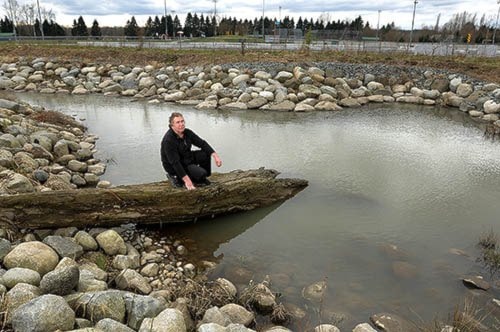Some fingerling coho salmon showed up in Spencer Creek a few years ago and raised expectations with a local stream group.
Now, baby coho have been spotted again, in larger numbers, leaving the Kanaka Education and Environmental Partnership Society with hopes that the muddy course traversing the Albion flats, beside Lougheed Highway, past ice rinks and sports fields, is now a salmon stream.
Last week, 26 juvenile coho minnows were caught in a trap in Spencer Creek, just upstream from the gate that connects Spencer Creek to Kanaka Creek, near the Maple Ridge Hyundai dealership.
“What’s changed is the actual number of coho. We’ve never seen that many in that big of a concentration. This is the first pretty conclusive evidence that some adults were getting through, too,” said Ross Davies, with KEEPS.

Adults have been able to move upstream from Kanaka Creek thanks to a fish-friendly pump installed in 2010 at Lougheed Highway and Tamarack Lane.
The gate allows fish to move back forth, up and downstream, while the pump station regulates water flow.
A $310,000 grant from the Pacific Salmon Foundation helped pay for the new pump station.
With that many fingerlings found, it  shows that adult coho have made it through the gate into Spencer Creek and spawned, probably near Stratford Avenue and Albion Park.
shows that adult coho have made it through the gate into Spencer Creek and spawned, probably near Stratford Avenue and Albion Park.
Coho salmon usually prefer smaller, urban streams, particularly in the Lower Mainland, putting them at risk of the effects of development.
Unlike the chum salmon, which come upstream in big numbers and splash around and spawn, coho are a shy fish, Davies said.
“You have to be lucky to see them,” he added.
“Sometimes, they’ll spawn at night and hide during the day.”
That was discovered during a study which showed the coho were sneaking into a tributary of Spencer Creek at night to spawn, then moving back into Kanaka Creek in the daytime.
Spencer Creek has seen a series of improvements since 2006. The surrounding topography farther upstream has been improved as land has greened over and construction completed, reducing sedimentation.
The beneficial effects of the pump and a new fishway beneath 104th Avenue has made it easier for coho to cross that street, compared to a culvert that used to be there.
As well, some upstream sections in the newer suburbs of Albion flats near the Albion Sports Complex have been improved with new planting of trees and shrubs along the bank and woody debris added to the water course to provide cover for fish.
Overall, Spencer Creek is probably 50 per cent healthier than it was a decade ago, Davies said.
Davies added that the banks of the stream in the lower sections, from Planet Ice on down, also should be improved and widened to provide more shade cover and nutrients for the fish.
The presence of coho in Spencer Creek, though, won’t have much effect on any future development because the stream setbacks that protect streams are already in place.
Students at Samuel Robertson Technical school have also played a role for the last decade by regular monitoring of the water quality as part of their environmental studies.
“This is just another chapter in the rebirth of Spencer Creek, which started about 11 or 12 years ago,” Davies said.
Success breeds success, he added.
“Your creek goes from the problem child to the poster child.”
He was surprised to see find the baby coho in the lower, muddier part of the stream, just upstream of the gate.
“You just gotta love those wild coho, what they’re able to do.”
It’s not the first time coho have been in the stream, but it’s the largest number, said Maurice Coulter-Boisvert, a community adviser with Fisheries and Oceans Canada.
And there’s reason for optimism for a continued coho population.
“There’s every reason to expect that,” Coulter-Boisvert said.
Access for fish and good water quality are both needed to sustain fish populations, he said.
“If both of those are maintained, then there’s good hope that the populations will continue to go up, to the extent of the available habitat.”
If fish can move in and out of the stream without being killed by a pump, “then there’s every reason to be optimistic.”
He added that chinook salmon could also move into Spencer Creek in the springtime as they move down the Fraser River.
